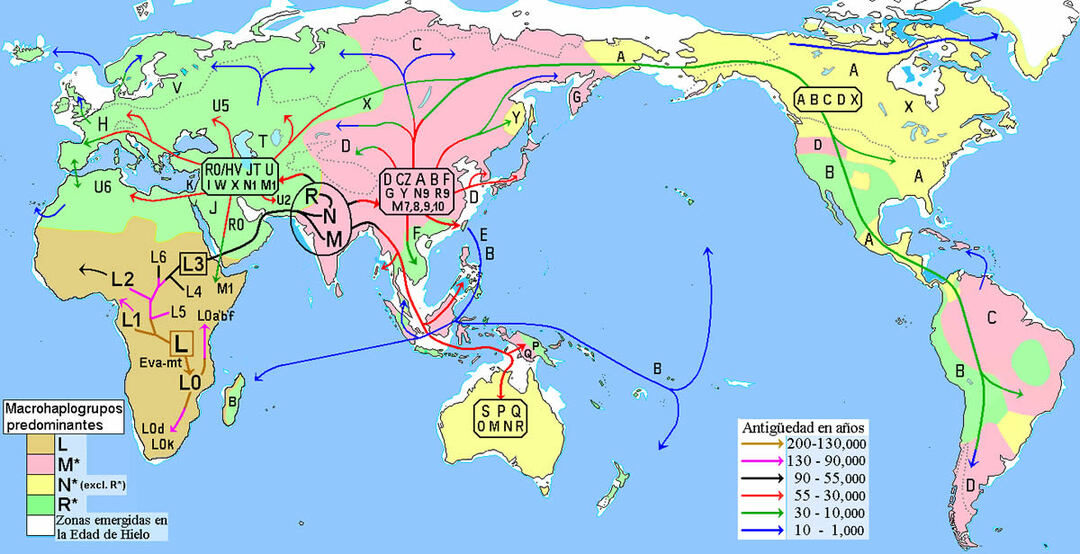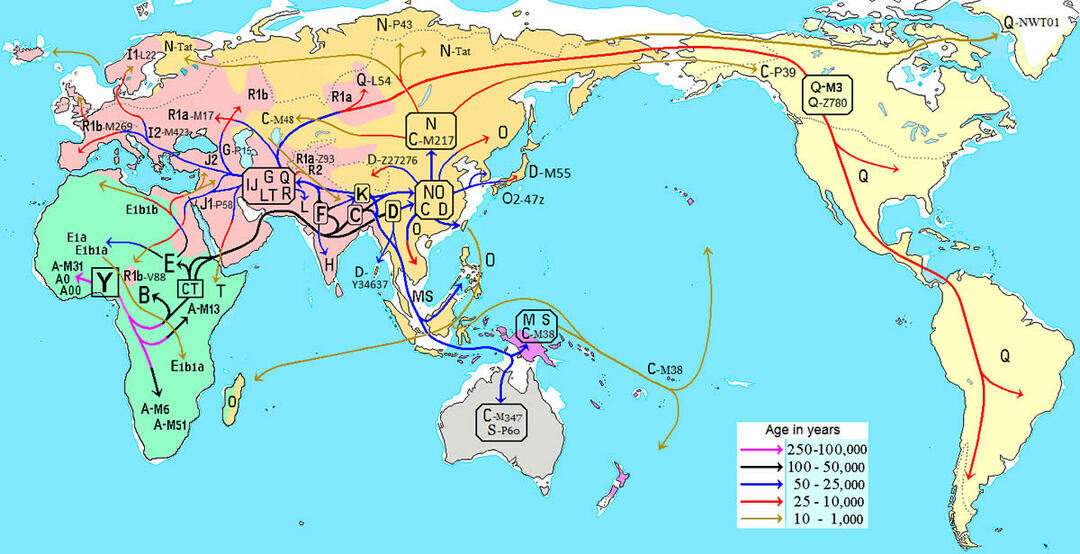Definition of the Population of America
Population Of America Guernica Bombing Battle Of Trafalgar / / April 02, 2023

Lic. in Physical Anthropology
The settlement is a phenomenon that involves the human being in his search to locate a territorial space that meets the answers to his needs and allows him to develop among peers in view of new generations, according to the constitution of a community, as part of its foundation or joining it from another origin. Interest in studying the Americas has led some researchers to ask: How and when did people get there? What is the origin, and why are American populations so diverse? To provide answers, different methodologies have been used, such as archaeology, geology, even linguistics, and a much more recent one: genetics.
From the investigations that include genetic data, some important questions have been resolved, for example, the issue of the dates when humans arrived at this continent. For years it was certain that human beings populated North America (what is now the United States) 11,000 years ago. years at most and that, therefore, no older human records could exist in South America or in Central America. This first culture was given the name Clovis, in reference to projectile points found in the town of Clovis, New Mexico, United States; these artifacts have a wide
distribution in the northern portion of the continental mass, including the state of Sonora, Mexico; With these data, archaeologists from the second half of the 20th century felt sure that human groups had crossed the Bering Strait very recently.However, with analysis of dna mitochondrial, other much older dates of entry were proposed, these conclusions also made sense of some findings of human remains and archaeological sites with more than 11 thousand years and that are located in the center and south of the continent, for example, the site of Monte Verde in Chile that has at least 14,800 years old, or the skeleton of a woman found in the Naharon cenote, Quintana Roo, Mexico whose age is around 13,600 years. Although the dates calculated from genetic studies have very large ranges of difference, they allow us to propose other hypothesis and direct future research.
Two determining waves of migration and the groups associated with them
For a long time, a three-migration model was used, which stated that each wave migration gave rise to three Native American language families: Na-Dene, Aleut-Eskimo, and Amerindian. This hypothesis already included the evidence genetics, which consisted of the concordance of some mitochondrial haplotypes with the three large linguistic families and recognized their similarity with a common Asian haplogroup. In addition, it was supported by other studies that characterized Native Americans as Northeast Asian descendants based on dental evidence reported by archaeologists and anthropologists. Later, investigations that included mitochondrial genes propose that America was populated by only two migratory waves, one containing Amerindian groups and another Na-Dene groups.
The first migration It was estimated between 26,000 and 34,000 years ago, from Central Asia, and contained haplogroups A, C, and D; the second migratory wave would have occurred between 12,000 and 15,000 years ago, the latter would be the one that introduced haplogroup B to America. More recent genetic studies support the idea of Siberian descent from Native Americans, and the entry of man through Beringia in a range of 26,000 to 18,000 years ago; It is possible that these groups remained there for a time until they spread across America a few years ago. 17 thousand years ago, which would explain the exclusive mitochondrial mutations of populations american. Studies of the sequences of the four founding haplogroups obtain dates very similar to the previous ones, ranging from 18,000 years to 24,000 years before present; and a great variety of haplotypes are also found on the continent, however they are only found six founder haplotypes (A2, B2, C1b, C1c, C1d and D1), the rest originated after entry into America. Previous lineages identify a correspondence with Asian roots, however, less frequently than in the American Continent; lineages A, B, and C are not identified in present-day Africans and Caucasians; For its part, lineage D, which exists in Africa, is linked to other regions, based on mutations other than those of the Americas.
How is the diversity of the population of America explained?
To explain the diversity in the founding lineages, there are two hypotheses: that America has been colonized by multiple migrations from Beringia, or that microevolutionary changes have already occurred within the continent after these first establishments populations. Two entry routes are also known that can explain this diversity in the continent, the first proposes that the four founding haplogroups without variations, that is, each with a root haplotype, could have arrived just after or slightly before the Last Glacial Maximum, with dates of 21,000 to 19,000 years ago, and would have followed a coastal route along the Peaceful; the second proposal suggests that these intra-haplogroup variations already existed in Beringia and were brought to the south of the American continent but their entry would have been exactly at the end of the Last Glacier Maximum so that the possible paths within the continent would already be free, so the entry of these human groups would be 19 years ago. a thousand years. There is also a great diversity of haplogroup A and a coalescence time for it that is shorter than for the rest (17 thousand years); the most likely explanation is due to secondary expansions of haplogroup A from Beringia, long after the end of the Last Glacial Maximum.
Despite the discrepancy regarding the time of entry of man into America, genetic studies have achieved give some clarity, because they support the hypothesis that human groups existed on the American continent before Clovis; and it is found that there is a separation between the ancestors of northeast Asia 25-35 thousand years ago and the entry into America 15-35 thousand years ago.

Figure 1. Routes of mitochondrial haplogroups in the world and the time of divergence in years before present. From Maulucioni, Wikipedia.
Another marker that has given valuable information on the subject of the population of America is the Y chromosome, which is only inherited from fathers to sons without recombination. This chromosome also has various haplogroups with a differentiated geographic distribution. Haplogroups A and B of the Y chromosome are the oldest, those that refer to the origin of Homo sapiens in Africa because they are exclusive to this continent. The R haplogroup is found in much of Europe and the C and Q haplogroups appear to arise in northwest Asia, and are the only ones that reached the Americas at the time of peopling.
According to some authors, the Q-M3 mutation is 13,800 years old, that is, a late entry to the continent according to the times calculated from mitochondrial DNA; however, other authors find that the Q-M242 variant is between 15,000 and 18,000 years old and that it seems to be a better marker to study the population of America by Being a variant that arises in Central Asia before Q-M3, it also coincides with the moment of a second migratory wave proposed by the aforementioned mitochondrial DNA studies. above. It is likely that haplogroup C of the Y chromosome, although older than Q, entered the Americas after Q, however, the Haplogroup C is only found in the northernmost portion of the American continent, in the area where the language families are located. Na-Dene.
The Q haplogroup is the most frequent in America and has a great variety of haplotypes, the most frequent are: Q-L400, Q-P89.1 (in the northwest Canada), Q1a2a1 (found among the Maya and in a 12,600-year-old child burial belonging to the culture Clovis); Q-M3 (also common in eastern Siberia) and Q-M191 that has a distribution in Mexico. In summary, the Q haplogroup has a prevalence of 76.4%, specifically 52.6% belongs to the Q-M3 haplotype and 23.8% to QP36. Haplogroup C is found in 5% of Native Americans and is rare in the rest of the world except for North Asia, where it has a frequency of 28%.

Figure 2. Map illustrating the distribution of the different Y chromosome haplogroups around the world and the time period in which they could have arisen. From Maulucioni, Wikipedia.
References
Greenberg, J., Turner, C., Zegura, S., Campbell, L., Fox, J., Laughlin, W., et al. (1986). The settlement of the Americas: A comparison of the linguistic, dental, and genetic evidence [and comments and reply]. Current Anthropology, 477-497.Torroni, A., Schurr, T. G., Yang, C. C., Szathmary, E. J., Williams, R. C., Schanfield, M. S., and others. (1992). Native American mitochondrial DNA analysis indicates that the Amerind and the Nadene populations were founded by two independent migrations. Genetics, 130(1), 153-162.
Underhill, P. A., Shen, P., Lin, A. A., Jin, L., Passarino, G., Yang, W. H., and others. (2000). Y chromosome sequence variation and the history of human populations. Nature Genetics, 26, 358-361.
Zegura, S. L., Karafet, T. M., Zhivotovsky, L. A., & Hammer, M. F. (2004). High Resolution SNPs and Microsatellite Haplotypes point to a single, recent entry of Native American Y Chromosomes into the Americas. Molecular Biology and Evolution, 21(1), 164-175.

